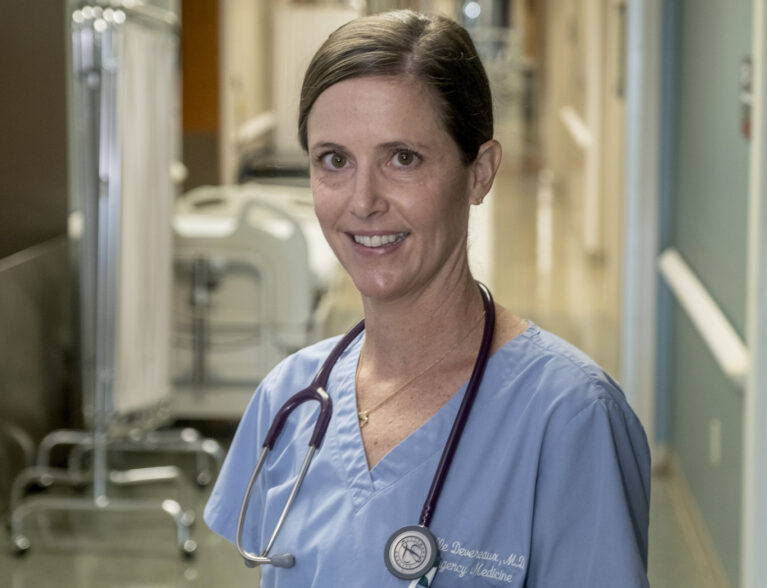
Not so long ago, concussion was brushed off as a temporary affliction, but that turned out to be a costly mistake. Data from the Centers for Disease Control and Prevention (CDC) indicates there are nearly 3 million significant head injuries in the U.S. each year and nearly 300,000 of these affect children and adolescents who sustain concussions during sporting activities that can lead to long-term problems.
Dr. Danielle Devereaux directs the Pediatric Emergency Department at Health First’s Holmes Regional Medical Center and she said that, in the decade or so since she completed her residency, the way childhood concussion is treated has changed dramatically and continues to evolve as more is learned about it.
“Previously, treatment took place based on our focus on physical symptoms, but now we realize – that especially with youngsters as compared to adults – symptoms can include cognitive issues such as abnormal sleep cycles, irritability and tearfulness,” said Devereaux.
The name of the game used to be to prescribe rest after a concussion was diagnosed, she added. But not anymore.
A University of Michigan study published earlier this year reports people who do light exercise within 48 hours after a concussion saw their symptoms resolve in about half the time as those who waited more than a week to exercise.
The study added to the growing body of science suggesting that “cocoon therapy” – bed rest in the dark with minimal mental stimulation after concussion – isn’t good for patients.
Devereaux agreed. Things like video games and TV are OK so long as they don’t cause symptoms to worsen.
The Michigan Study reported that the biggest beneficiaries of early exercise might be people who are likely to develop persistent concussion symptoms – those that linger past four weeks.
The Concussion Legacy Foundation reported that in the majority of cases, symptoms resolve within two weeks. When issues continue for longer periods, doctors may diagnose Post-Concussion Syndrome (PCS).
According to Mayo Clinic, symptoms of PCS aren’t necessarily different from symptoms of a regular concussion but last considerably longer. They include:
- Headaches
- Dizziness
- Fatigue
- Irritability
- Anxiety
- Trouble falling asleep or sleeping too much
- Loss of concentration and memory
- Ringing in the ears
- Blurry vision
- Noise and light sensitivity
- Rarely, decreases in taste and smell
Headaches after a concussion most often feel like tension-type headaches or migraines. Mayo advises that anyone who experienced a head injury that caused confusion or memory loss see a healthcare provider immediately, even if they remained conscious. If it occurred while playing a sport, don’t go back into the game.
Devereaux said that as children get older, getting them to deal with concussion protocols tends to be more complicated. They may want to return to playing sports sooner than they should.
The CDC is just one of the organizations that has provided guidelines for school professionals regarding children’s return to the classroom after they suffered a concussion and all agree that parents, teachers/principals and medical providers must work as a team.
Devereaux advises parents to discuss the seriousness of concussion with their children and the importance of them telling their coach, teacher or parent if they may have suffered a blow to the head. She added that once a kid has had a single concussion with symptoms that lasted more than a week, they are at significant risk of having another one.
Psychology Today recently reported that there are two separate clinical trials starting up to see if dietary supplements can be effective in treating concussion.
One is a Canadian study of the effect of omega 3, vitamin D plus creatine on persistent post-concussion symptoms, and one is a U.S. study on melatonin in acute pediatric concussion.
Given that sleep disturbances are common after concussion and that many concussion symptoms (like trouble concentrating and irritability) mirror those of sleep deprivation, it makes sense a sleep aid might help treat concussion.
The same article discussed the use of thermal treatment immediately after head trauma to prevent or mitigate concussion symptoms. It cited a study just published in the Journal of Neurotrauma that looked at the impact of immediate head and neck cooling for concussed ice hockey players. Since increasing temperature after an injury can be harmful, causing more inflammation and cellular damage, researchers tested whether the same principle might apply to the injured brain and implemented a protocol of 45 minutes of immediate post-head injury cooling. So far, the science looks promising.
Devereaux said that CT scans are now rarely done on kids and teens unless the concussion shows indications of being severe. “They used to be done frequently but we learned they’re just not needed in the vast majority of cases. Anytime we can keep someone from being exposed to unnecessary radiation, we do.”
Although new protocols have revolutionized treatment of concussion and there is exciting new research being conducted, Devereaux said starting treatment quickly is still the most important step you can take to help your child heal.
Danielle Devereaux, M.D., is a pediatrics specialist and director at Health First’s Holmes Regional Medical Center Pediatric Emergency Department. She received her medical degree from Geisel School of Medicine at Dartmouth University. She has certifications from American Board of Medical Specialties, American Board of Emergency Medicine and American Board of Pediatrics. Holmes Regional Medical Center is located at 1350 Hickory St, Melbourne: 321-434-7000.



